Talkoniai
Talkoniai village, Pasvalys district, Lithuania
12 March 1905
On 12 March 1905 Alfonsas Lipnickas (in 1939 he changed
his surname to Lipniūnas) was born in Talkoniai village, Pasvalys district, Lithuania, into a Catholic
large family. He became a priest in 1930 and a prisoner of Stutthof concentration camp in 1943.
His parents were Dionizas and Konstancija Lipnickas.
Their native house was built along a dusty road, made of old logs and covered with a
thatched roof, but it was welcoming to travellers and carefully maintained.

More photos
Pumpėnai Blessed Virgin Mary Skaplierine Church
Ąžuolyno a. 1, Pumpėnai, Pasvalys district, Lithuania
14 March 1905
Alfonsas Lipniūnas was baptised on 14 March 1905 at
the Pumpėnai Church of the Blessed Virgin Mary Skaplierine.

More photos
Pumpėnai Primary School
Panevėžio st. 53, Pumpėnai, Lithuania
1917-1919
Parents, although they were farmers, were poor.
With 13 hectares of land, they had to feed their large family. In 1917, they let Alfonsas to the first
class of Pumpėnai Primary School. School was interrupted by a typhus epidemic. In 1918 Alfonsas continued
his education in the third grade of primary school. The boy was gifted, and graduated from primary school
with honours.

More photos
Panevėžys Boys Gymnasium
Now - Panevėžys Juozas Balčikonis Gymnasium, Respublikos g. 47, Panevėžys, Lithuania
1919-1925
On August 15, 1919, Alfonsas entered the third grade
of the Panevėžys Boys Gymnasium. From the 5th grade onwards, encouraged by his Lithuanian language teacher,
he began to keep a diary, which reveals the daily life of a virtuous, religious young man and his attitude
towards his surroundings. He enjoyed the literary parties, concerts and lectures at the gymnasium, was curious,
but usually did not stay for dancing, and avoided noisy entertainments. He began to think about a vocation
to the priesthood in the gymnasium before his final exams.

More photos
Grave of priest Alfonsas Lipniūnas in Panevėžys
Katedros a. 1, Panevėžys, Lithuania
On 12 September 1989, thanks to the efforts of Monsignor
J. Antanavičius, pastor of Panevėžys Cathedral, A. Lipniūnas' sister A. Jankevičienė and her son K. Jankevičius,
remains of priest A. Lipniūnas' were brought from Poland and solemnly reburied in the churchyard of the
Christ the King Cathedral in Panevėžys, as requested by Bishop K. Paltarokas.
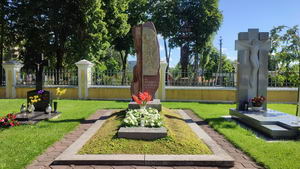
More photos
Panevėžys Cathedral
Katedros a. 1, Panevėžys, Lithuania
1930-1935
After his ordination to the priesthood, the young and
zealous priest receives his first appointment from bishop Kazimieras Paltarokas of Panevėžys. On 28 June 1930,
Father A. Lipniūnas was appointed Vicar of Panevėžys Cathedral and in September he was appointed the youth
leader of the Diocese of Panevėžys.

More photos
Panevėžys Cathedral rectory
Katedros a. 7, Panevėžys, Lithuania
1930-1935
Shortly after the First Holy Mass at Pumpėnai Church,
Alfonsas returnd to Panevėžys and wrote in his diary: “Here I am in Panevėžys. A tiny room in the Cathedral
rectory. One chair, a bed, a table and a bookshelf. Here is the first, dreamed-of place of my priesthood.“
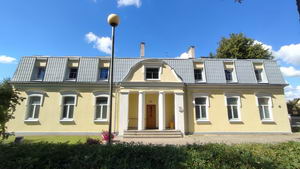
More photos
Panevėžys Prison
P. Puzino g. 12, Panevėžys, Lithuania
1933-1935
In addition to pastoral work and youth education,
while working in Panevėžys, Father Alfonsas was also concerned about the situation of marginalised and
excluded groups of society, their social and moral care - he visited prisoners in the prison of Panevėžys.
Several hundred prisoners in Panevėžys Prison willingly attended his lectures.
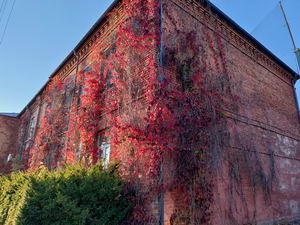
More photos
Panevėžys Pedagogical Institute
Ukmergės g. 56, Panevėžys, Lithuania
April - September 1939
In 1939, after returning from France, Father Alfonsas
was to start teaching religious methodology at the Panevėžys Pedagogical Institute, but as the Institute
moved to Vilnius, he also moved to Vilnius.

More photos
Apartment at Aušros Vartų street 27-15, Vilnius
According to the current numbering - Aušros Vartų street 23, Vilnius, Lithuania
1939 - 16 March 1943
In 1939, Father A. Lipniūnas rented a two-room apartment
in Vilnius at Aušros Vartų g. 27-15. One room was a parlour, a reception room, the larger room, and the
second, smaller room was a bedroom.
The apartment was the home of the Freedom Foundation, an organisation
founded in February 1941 to care for the poor. The support reduced public poverty, and the Foundation’s
material and moral support was important for students, the sick, widows and members of deported families.
On the night of 16 March 1943, the priest was arrested in his home and taken to Stutthof concentration camp.
Later, the Nazis registered all the remaining belongings in his apartment.

More photos
Chapel of Our Lady of Mercy at the Gate of Dawn
Aušros Vartų street 14, Vilnius, Lithuania
1939 - 16 March 1943
Father A. Lipniūnas began his ministry as a priest in
Vilnius at the Gate of Dawn, celebrating the mass at the miraculous image of Our Lady of Mercy.
Whenever A. Lipniūnas appeared on the balcony, there was no room to accommodate everyone at the street of
the Gate of Dawn. Even those who rarely went to church, who were not zealous believers, would come to listen.
Pointing out the wrongs of that time, Father Alfonsas did not seek to stigmatize or despise man, he did
not intimidate him with devils, suffering and hell, but always appealed to his conscience, and ended with
a hopeful thought - that it is possible to overcome one's own sinfulness, to struggle, like he would gently
tap his shoulder - saying: Man, you are great and precious, so be worthy of this name.
In 1941, during the Holocaust, he publicly defended the rights of the Jews from the Chapel of the Gate of Dawn.

More photos
State Pedagogical Institute
Aušros vartų g. 7A, Vilnius, Lithuania
1 December 1939 - 1 July 1940; 30 January 1942 - 16 March 1943
In the autumn of 1939 the State Pedagogical Institute
was moved from Panevėžys to Vilnius. In Vilnius, the Institute was established in the former Basilian
Monastery. The address of the Vilnius (State) Pedagogical Institute's building at that time was Aušros
vartų g. 9 (now Aušros vartų g. 7A).
Father A. Lipniūnas taught sociology and religion at this
educational institution. He also became the chaplain of this institute. In June 1940, when the Soviet
army occupied Vilnius, Father Alfonsas lost his position at the Pedagogical Institute.

More photos
Lithuanian National Philharmonic
Aušros vartų str. 5, Vilnius, Lithuania
1939 - 16 March 1943
Father A. Lipniūnas was a social activist who actively
maintained contacts with the small but prominent Lithuanian intellectual elite in Vilnius. The poet Kazys
Bradūnas wrote in his memoirs: “Although we were blindly separated from the development of world literature,
there was no shortage of literary afternoons and public literary evenings in the city at the Philharmonic
for the literary students of the university. We already reading our student work on such occasions outside
the walls of the university. A. Lipniūnas was also there in the audience for recitals and evenings.”

More photos
Vilnius Theological Seminary
Now the Church Heritage Museum, Šv. Mykolo street 9, Vilnius, Lithuania
7 September 1942 - 16 March 1943
The Bernardine Monastery next to St. Michael's Church
hosted the Vilnius Lithuanian Priest Seminary, where Father A. Lipniūnas taught 4 subjects: Sociology,
Pastoral Theology, Ethics and Catechetics. Father Alfonsas did not follow a textbook, but rather spoke
more about relevant issues, drawing on his experience and formulating conclusions from it.

More photos
St. John's Church
in the last decade of the twentieth century, St. John the Baptist and St. John's Evangelist and Apostle's Church in Vilnius was abbreviated not as St. John but St. Johns’. Address - St. Johns’ str. 12, Vilnius, Lithuania
1940 - 16 March 1943
In 1940, the Archbishop of Vilnius, M. Reinys,
recommended that Father Alfonsas become a preacher at the Church of St. Johns. The sounds of Father
Alfonsas’ sermons powerfully echoed in the vaults of St John’s Church. Not only Catholics, but also by
people of lesser faith, evangelicals, and leftists were coming to listen to Father Alfonsas. The
newspaper Naujoji Lietuva printed advertisements about the schedules of future sermons of Father
Alfonsas Lipniūnas in the church. In the church, the Soviet security listened to Father Alfonsas’ sermons.
In 2016, Father Alfonsas Lipniūnas chapel was consecrated in the church of St. John.

More photos
Territory of the Little Ghetto
Now - Konstantinas Sirvydas Square in Vilnius, Lithuania
1941 - 16 March 1943
The Nazi occupation of Lithuania, which began in 1941,
led to the extermination of the majority of the Jewish population. The former Jewish Quarter included
the territory of the Little Vilnius Ghetto, established in September 1941. Father Lipniūnas knew what the
people living in the ghetto were going through, he criticised and prevented the theft and robbery of
Jewish flats and the taking of property.

More photos
Stefania Ladigienė's apartment at 11 Trakų Street, Vilnius
According to the current numbering - Trakų g. 10, Vilnius, Lithuania
1941 - 16 March 1943
Father Alfonsas often visited Stefania Ladigienė, who
was awarded the title of Righteous Among the Nations, and her family. S. Ladigienė's apartment was a
meeting point for the intelligentsia and the centre of Catholic resistance thought. Archbishop M.
Reinys, Father A. Lipniūnas, Father L. Tulaba, poet F. Kirša, J. Keliuotis, B. Sruoga and others also
visited the apartment. Today, the space of the former apartment serves as a library reading room.
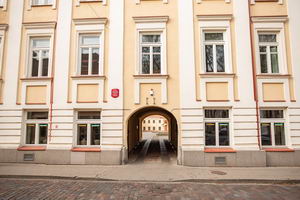
More photos
Vilnius Cathedral Basilica and rectory
Katedros a. 2, Vilnius, Lithuania. Rectory - now the Parish House, Tilto str. 1, Vilnius, Lithuania
1940 - 16 March 1943
Father Alfonsas was invited to Vilnius Cathedral Basilica
to give sermons during recollections. Father Alfonsas had meetings with schoolchildren in the rectory of the
Cathedral. When resuming broadcasts of Holy celebrations on Lithuanian radio, on 28 February 1943, the Lithuanian
Vilnius Radio Station administration planned to start them with the Holy Mass by Father A. Lipniūnas from
Vilnius Cathedral, however, on the eve of 27 February, the Nazis cancelled this broadcast.

More photos
Prison in Vilnius
Now the Museum of Occupations and Freedom Struggles, Aukų g. 2A, Vilnius, Lithuania
16 March 1943 - 17 March 1943
The current Museum of Occupations and Freedom Struggles
served as the headquarters of the German secret security police (Gestapo) and the SD, its prison, and the
barracks of the Vilnius Special Squad, which carried out actions against the Lithuanian population,
between 1941 and 1944.
On 16 March 1943, the Nazi Gestapo arrested Father Alfonsas at his home in
Vilnius and later deported him to the Stutthof concentration camp. It is likely that Father Lipniūnas
might have been held in this prison before deportation. In 2018, Pope Francis visited this museum
while visiting Lithuania.
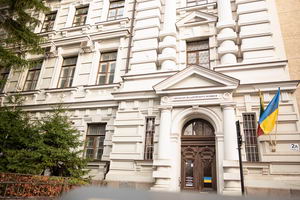
More photos
Kaunas Spiritual Seminary of Samogitian Priests
A. Jakšto g. 1, Kaunas, Lithuania
1925-1930
In the autumn of 1925, A. Lipniūnas entered the Kaunas
Seminary. At the seminary he attended the following groups: ateitininkai, scouts, art and nature. He
remained in the memory of his friends as a young man who was absorbed in books, well-read, and eager to
share his knowledge in the meetings of the seminarians' groups. Father Alfonsas Glaveckas remembers his
co-student as someone who, in the seminary, took a special interest in the social life of the Church,
and when “...speaking or praying, his smiling face always had a generous soul shining through. A.
Lipniūnas did not have great innate talents as a speaker, but his words were lively, simple, burning
with love, and tinged with noble simplicity.”

More photos
Faculty of Theology of Vytautas Magnus University
Gimnazijos g. 7, Kaunas, Lithuania
1926-1932
A. Lipniūnas studied at the Theology Department of
the Faculty of Theology and Philosophy of Kaunas University. On 11 June 1930 he graduated from the
Faculty of Theology and Philosophy of Vytautas Magnus University in Kaunas and received a diploma of
theology. On 13 February 1932 he passed the examinations of the Licentiate of Theology in Kaunas.

More photos
Kaunas Cathedral Basilica
Vilniaus g. 1, Kaunas, Lithuania
14 June 1930
On 14 June 1930 Metropolitan Juozapas Skvireckas
conferred the sacrament of priesthood on A. Lipniūnas at Kaunas Cathedral Basilica. At the end of the
seminary, he wrote a plan in his diary - “What to observe when going out into life, so that the fiery,
determined spirit does not grow cold, and so that the apostolate is successful.”

More photos
School of Social and Political Sciences, University of Lille
École des Sciences Sociales et Politiques de Lille, 42 rue Paul Duez, Lille, France
1935-1937
In 1935, Bishop K. Paltarokas of Panevėžys offered
Father Alfonsas to further his studies abroad. From 1935 to 1937, A. Lipniūnas studied sociology at the
School of Social and Political Sciences of the University of Lille. He also took a one-year course at
the École des Missionnaires du Travail in Lille.
Institut Catholique de Paris
Institut Catholique de Paris, 21 Rue d‘Assas, Paris, France
1937-1939
From 1937 to 1939, Father Lipniūnas studied at the
Faculty of Social Sciences of the Institut Catholique de Paris, taking four courses in sociology. He
returned from his studies as a licentiate in social, economic and political sciences, but never completed
his dissertation. He was sure that he had not wasted his time, and wrote to the bishop after completing
his 4-year studies in France: “I know myself that diplomas do not mean much, so I do not value it.
The most important thing is knowledge, and especially the ability to use it.”
Stutthof Concentration Camp
Muzealna 6, Sztutowo, Polska
26 March 1943 - 25 January 1945
After the arrest in Lithuania in March 1943, 46
Lithuanian intellectuals were brought to Stutthof concentration camp on 26-27 March (A. Lipniūnas on
26 March). Father Alfonsas was assigned the prisoner number 21 332.
The Lithuanian intellectuals were initially placed in the second block. Since May, the changed circumstances of
imprisonment allowed Father Lipniūnas, with the help of Father Yla, to organise a secret religious life.
It is known that in January 1945 about 500 prisoners in Stutthof took part in secret religious life. This was an
illegal activity for which the death penalty was threatened. Father A. Lipniūnas risked his life.
Religious activities were carried out in blocks 8A, 8E and 11.

More photos
Przodkowo
Poland
January 1945
On 25 January 1945, the evacuation of the Stutthof
concentration camp began. Under Nazi supervision, 11,000 concentration camp inmates walked through the
snow and cold on an approximately 200 kilometre long Death March, which ended on 11 March 1945
in the city of Puck, Poland.
In Przodkowo, Father A. Lipniūnas did not lack courage and celebrated Mass in the church in Przodkowo.
Near the church there is a mass grave of the martyrs of the Death March.

More photos
Łebno
Poland
January 1945
In Łębno, the Death March prisoners spent the
night on 29-30 January 1945. Father A. Lipniūnas celebrated the St. Mass in the school building,
where he prayed for the prisoners who died and were murdered during the march. It is estimated that
as many as several dozen prisoners died during the Death March in and around Łębno.
There is currently one mass grave of Stutthof prisoners in the town's cemetery.

More photos
Krępa Kaszubska
Poland
Krępa Kaszubska is one of the most important sites
of the Death March, commemorating the tragic fate of the people imprisoned at Stutthof.
In 2000, a memorial room was opened in one of the classrooms of the former primary school,
where information about the participants of the Death March is presented,
along with historical information, documents, photographs, and remaining memorabilia.
Mykolas Pečeliūnas, a former prisoner of the Stutthof concentration camp and a good friend of Father
Alfonsas Lipniūnas, was also present at the opening of this small museum.
In this area, the prisoners of the fourth column were accommodated in four wooden barracks for five weeks.
In 1945, over 300 prisoners died here as a result of exhaustion, inhumane sanitary conditions,
starvation and an outbreak of typhus.

More photos
Gęś
Poland
From February to 9 March 1945
The Stutthof prisoners spent as long as 5 weeks in Gęś.
The prisoners were starving and freezing because the walls of the temporary barracks were made of boards
and it was cold outside. On the evening of 21 February 1945, the son of the first President of Latvia,
Prof. Konstantin Čakste died. He was buried in Gęś and prayers were said for him by Father S. Yla. Although
K. Čakste was a Protestant, Father Lipniūnas and Yla gave him a proper Christian burial.
On 9 March 1945, a column of evacuated prisoners was driven out of Gęś in the direction of Puck. The last stage
of the Death March was particularly difficult for Father Alfonsas who contracted typhus from other prisoners.
A monument has been erected to commemorate the participants of the Death March in the village of Gęś, on the
site of the former evacuation camp. In the centre of the monument is a plaque resembling the Baltic gold -
amber - inscribed with the numbers of the prisoners who died in the hospital, while the larger grey front
part of the monument is embossed with the different inscriptions of the prisoners of the Stutthof concentration
camp, with fragments of the nationalities of the prisoners - Polish, Lithuanian, Latvian, Russian, and German.
The path leading to the monument is paved with cross-shaped tiles, symbolising the path of suffering that the
prisoners of the Stutthof concentration camp had to follow.

More photos
Puck's Church of Saints Peter and Paul
Judyckiego 4, Puck, Poland
12 March 1945
The prisoners of the Death March reached Puck
on 11 March 1945. They spent their last night in Puck in an abandoned building. On the morning of 12 March,
the prisoners were liberated by the Soviet army and the Nazis escaped. Among them, Father Lipniūnas.
The day of liberation coincided with the priest's 40th birthday. A group of the newly liberated headed towards
the Church of Saints Peter and Paul in Puck, where Father Alfonsas had a thanksgiving service for liberation.
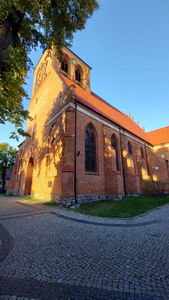
More photos
Home of Urszula Jankowska
Jana III Sobieskiego 5, Puck, Poland
March 1945
The widow Urszula Jankowska, whose husband was shot
by the Germans in 1939, agreed to accommodate Father Lipniūnas, who took up residence in the ornate living room.
Lithuanian friends who came to visit him found Father Alfonsas quiet, thoughtful and low-spoken. He spent more
time in his room, reading and praying. From this home, the priest, weakened by spotted typhus, was taken
by his fellow prisoners to a hospital in Puck.
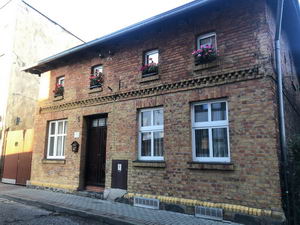
More photos
Puck Hospital
1 Maja 13A, Puck, Poland
28 March 1945
With typhoid fever contracted during the Death March,
Father A. Lipniūnas was admitted to the hospital in Puck at the end of March 1945. The hospital was staffed
by the prisoners.
Father Yla in his memoirs painfully recounts the last hours of life of Father A. Lipniūnas: “The shadows
of death were on the face of our Alphonse. His eyes without any signs of life. His gaze is eerie, his mouth
is dry, he barely breathes. [...] His pupils turned in my direction. His arms can no longer hold on,
but I can feel his chest moving even harder. I try to give him a Communion crumb with a spoonful of water.
He does not swallow. Such pain in his face! I understand: He would so much like to receive Him now.
“Alfonsas, Alfonsas!” - I can barely hold back my tears. I sit beside him, holding his hand. And he turns
to me and wants to say something. He barely moves his lips, barely turns his eyes. I get close - maybe
I will hear his last word. Nothing! He coughs and sighs. Any minute could suffocate him, I fear. He looks
at me again. This time his lips do not try to say anything. Only two big tears are stuck in his lashes.
I stroke his hand and try to soothe him. The tears roll down my cheeks - the last tears of goodbye!
And his eyes go out.”
At noon on 28 March 1945, Father Alfonsas Lipniūnas died in a hospital in Puck.
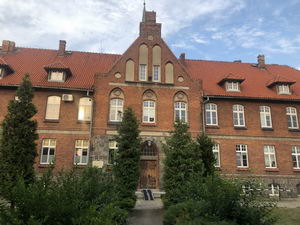
More photos
Puck Cemetery
Aleja Lipowa 5, Puck, Poland
31 March 1945
The death of Father Alfonsas caused difficulties on
the part of the civil authorities, nobody wanted to organise a separate burial, let alone Christian and
solemn, and did not want to give permission to bury him in the town cemetery.
The dead were buried in a common grave, but the prisoners arranged Father Lipniūnas, who had the opinion
of a martyr, to be buried in a separate grave and as befitted a clergyman. At the request of the former
Stutthof prisoners, a Polish policeman took some photographs of the funeral, which have survived to this day.
Father A. Lipniūnas was buried on Holy Saturday, 31 March 1945, in the cemetery in Puck. The grave was
tended, a monument as erected, flowers laid and prayers offered. In 1971, Father S. Yla erected a new monument.

More photos
St. Casimir Academy Auditorium
2601 W. Marquette Rd. Chicago, IL 60629, USA
On 13 June 1933, Father A. Lipniūnas arrived to Chicago.
On 16 June, he attended a ceremony at the auditorium of St. Casimir's Academy, where Bronius Balutis,
Lithuanian Envoy Extraordinary and Plenipotentiary Minister to the USA, presented the Order of the Grand
Duke Gediminas of Lithuania to Mother Mary Kaupas, Superior General of the Congregation of the Sisters of
St. Casimir. Almost 200 guests attended the ceremony.

More photos
Nativity BVM Church, Parish Hall, and Rectory
6812 S. Washtenaw Ave. Chicago, IL 60629, USA
In 1933, during a visit to Chicago, Father A.
Lipniūnas settled in the rectory of the parish of the Nativity of Mary. On June 18, he preached a sermon
on the Feast of Corpus Christi.
While in Chicago, Father A. Lipniūnas participated in the name-day celebration of vicar Petras Katauskas
on July 2, 1933. He said a prayer before the dinner and during the dinner he conveyed greetings from Lithuania.
The 21st Vytis Seimas was held on 8-10 August 1933. It began at 9 a.m. with the Holy Mass at the Holy Lady
Mary's Birth parish church of Chicago. Father A. Lipniūnas, who was the youth director of the Diocese of
Panevėžys, represented 70 thousand pavasarininkai workers and was authorized to present to the Seimas the
Unity Act of the pavasarininkai-Vytis. Both organisations had the same goals - to renew all things in Christ
and to promote the well-being of their people. Father A. Lipniūnas said a word of greeting at the Seimas
from the Ateitininkai, the Women's Society, the Angelaitis and personally from Prof. Pranas Dovydaitis,
Prof. Juozas Erets and Dr. Jonas Leimonas. In the evening a banquet was held in the parish hall.

More photos
St. George Church (demolished)
33rd Pl. and Lituanica St., Chicago, IL 60608, USA
Father A. Lipniūnas attended the 25th anniversary
of the priesthood of Prelate Mykolas Krusas, which took place on 18 June 1933 in Chicago, at St. George's
Parish Hall after the morning service in the church. About 600 guests attended. The church was demolished
in 1990 and the school and parish hall are still standing.
St. George Parish Hall and School, 32nd Place
and Lituanica St. Chicago, IL 60608, USA

More photos
Birutė Picnic Grove
Archer Ave. and 79th Ave., Justice, IL 60548, USA
The Centennial Progress outing organised by the
Lithuanian-American newspaper Draugas took place on 9 July 1933 in Chicago, at Birutė's Garden,
at Archer and 79th Streets, in the suburb of Justice. Father A. Lipniūnas gave a speech there. The square
was irrigated in advance to prevent dust, and truck owners transported the participants for a small fee.
Rūta Picnic Grove
2339 W. 23rd Pl., Chicago, IL 60608, USA
The organizing committee of the Centennial Progress
of Lithuanian-American newspaper Draugas held a thank-you dinner for all the workers, sponsors and
truck drivers of the outing. Guests from Lithuania, including Father A. Lipniūnas, were also honoured.
The tribute took place on July 11, 1933, at Ruth's garden in Chicago.
St. Anthony Parish Hall
49th Ct. and 15th St., Cicero, IL 60804, USA
Lithuanian Vytis together with the Women's Union of
Chicago County prepared a reception and tribute for the Lithuanian Pavasarininkai representatives on July 14,
1933 in the parish hall of St. Anthony in Cicero. The guests of honour were Adv. Stasys and Adelė Gabaliauskas,
Father Alfonsas Lipniūnas, Father Matas Šermukšnis and Father Kazimieras Matulaitis, MIC.
Young people were especially encouraged to attend this gathering and to interact with the guests.

More photos
Chicago World Fair 1933
(Century of Progress International Exhibition) Hall of
Science Burnham Park (approximately between 14th and 18th Streets) 1200-5700 S. Jean-Baptiste Pointe
DuSable Lake Shore Dr. Chicago, IL 60615, USA
On 16 July 1933, Father A. Lipniūnas participated in
the Centennial Progress Exhibition on Lithuanian Day in Chicago. The ceremony took place in the Science
Hall Square on the shore of Lake Michigan. The program included an academic part with lectures and a musical
part with songs, concerts and dances. There was also a sports match. Participants from Lithuania:
Father Antanas Deksnys, Father Dr. Kazimieras Matulaitis, MIC, Father Matas Šermukšnis, Adv. Stasys
and Adelė Gabaliauskas.

More photos
Hotel Knickerbocker
(presently Millennium Hotel Knickerbocker), 163 E. Walton Pl., Chicago, IL 60611, USA
On July 17, 1933, the Lithuanian Day Banquet of the
Centennial Progress Exhibition was held at the Knickerbocker Hotel in Chicago. Guests from Lithuania,
including Father A. Lipniūnas, attended. The program was changed due to the tragic deaths of pilots Captain
Stephen Darius and Lieutenant Stasys Girėnas.
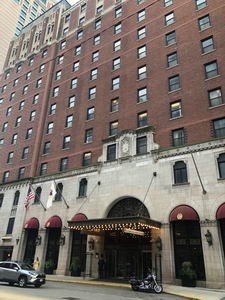
More photos
Shoreland Hotel
5454 South Shore Dr. Chicago, IL 60615, USA
The Lithuanian American Bar Association hosted a reception
to honour the guests who came from afar for the Lithuanian Days of the Centennial Progress Exhibition,
including Father A. Lipniūnas. A gala dinner was held on July 19, 1933 at the Shoreland Hotel in Chicago.

More photos
Immaculate Conception Church and Parish Hall
4400 S. California Ave., Chicago, IL 60632, USA
On August 9, 1933 the following evening, a play
Andriaus Šelmystės was staged at the parish hall of the Immaculate Conception of Mary, directed by
Father Antanas Valančius. The musical part of that evening was performed by Dainos Vytis Choir
under the direction of the musician Juozas Sauris.

More photos
McKinley Park Field House Auditorium
2210 W. Pershing Rd., Chicago, IL 60609, USA
The 23rd Congress of the Lithuanian Roman Catholic
Federation of America began on August 22, 1933 with the St. Mass at the St. George's Parish Church in Chicago.
The first session began the next day at 9 a.m. at McKinley Park Auditorium Hall. Father A. Lipniūnas
gave the welcoming speech. He was elected honorary chairman and invited to the presidium. The second session
began at 2 p.m. Father A. Lipniūnas had a special mandate from the Lithuanian Catholic Action Centre to
attend the Congress and to greet it on behalf of the Centre. He gave a lecture on “The Holy Year and
Catholic Action”. Discussants: Father M. Kazėnas, Dr. Petras Atkočiūnas and Red. Antanas Kneižys further
elaborated on the ideas raised by Father A. Lipniūnas.
An artistic programme took place in the parish hall of the Immaculate Conception of Blessed Mary. The
first part was performed by the Dainos Vytis Choir and the second part by a 17-person ensemble,
which staged an entertaining two-act operetta O, Doctor!, directed by musician Juozas Sauris.

More photos








































